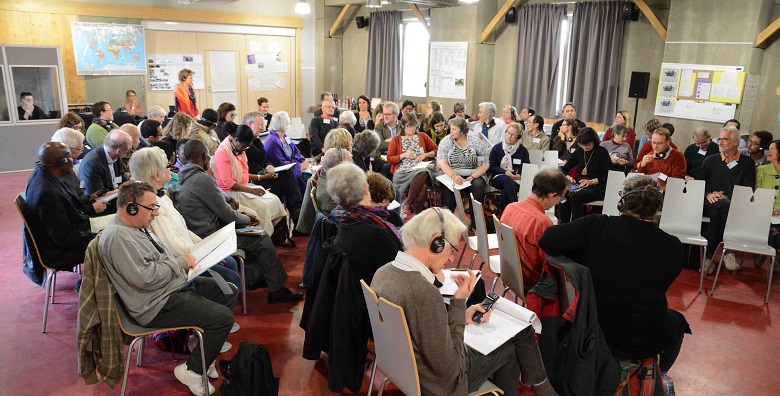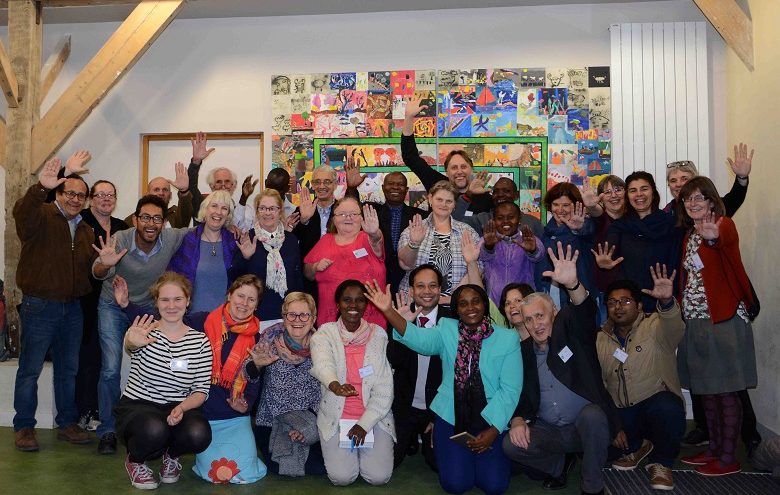Research on New Poverty Characteristics: One Year Report

ATD Fourth World is conducting an original study with Britain’s Oxford University in which people who have lived in poverty themselves will participate on an equal footing along with professionals and academics. Poverty is often defined without consulting people who experience it, and is measured solely according to monetary criteria. By including those who have lived in poverty in the conversation, ATD hopes to promote a less technocratic analysis of poverty, and to advance global ideas about the nature, characteristics, and measure of these poverty “dimensions”. A Multidimensional Poverty Indicator (MPI) should replace the extreme poverty indicator of $1.25 per day. An MPI would tell the whole story – not simply provide a numerical measurement.
From November 6-11, 2017, the participants in this international study met for seminars held in Villaceaux, France. After one year of research, the gathering provided an opportunity to evaluate the progress so far of their work in their respective countries, to view their preliminary results, and to get to know each other better. The three-year study, which includes six countries (Bangladesh, Bolivia, France, Tanzania, the United States, and the United Kingdom), will be completed in June of 2019.
The unique nature of this participant-inclusive study is the role played by those in precarious situations of poverty. These individuals are expected to be, and are recognized as, co-researchers. This work is based on the Merging Knowledge method developed by ATD Fourth World 20 years ago. The method consists of combining the “experienced based know-how” of people living in poverty, the “professional know-how” of practitioners such as social workers or educators, and the “research know-how” of academics. Its goal is to allow those living in poverty to become real partners in both acquiring and providing knowledge, as well as to contribute to the understanding of sustainable forms of development.
In this study, people living in poverty become new partners in the development of a knowledge base concerned with sustainable forms of development.
Alexie Gasengavire is the coordinator of the national research team in Tanzania. She talked about how, for this project, the team went to look for people working at the fish market and in the rock quarry of Dar Es Salaam. “It is not simple because, to take part in the workshops, you have to free up two and a half days,” explains a woman who breaks stones for a living. “I would really like to attend, but I have four children. I might get some food there; but my children, how are they going to eat?” In order to allow the most disadvantaged people to participate, the organizers decided to compensate participants for the wages they would lose by not working.
Creating the research team was one of the first challenges. First, proper conditions had to be created in order to enable people living in poverty to participate. It was also important to find academics that would agree to work as co-researchers on an equal footing with people living in poverty and with practitioners (such as teachers and social workers). Moreover, the academics had to accept payment lower than their usual fees in order to maintain equity within the research team.
Despite these challenges, national research teams were established in six countries, each composed of 10 to 17 members. In most cases, each team had two coordinators, one research assistant, four to six people living in poverty, and one person with the experience necessary to support those from disadvantaged backgrounds. In all, there are 81 co-researchers involved in these national teams.
In the first phase of the project, members of the research teams took time to get to know one other. They defined the roles and responsibilities of each person as well as work schedules, and addressed other practical issues to ensure a well-functioning project. They also allocated time for training on the ethical requirements and methodology of Merging Knowledge. They experimented with various suggested research tools and approaches, and chose the ones they found most appropriate. They also looked together at characteristics of poverty for adult populations of working age in urban and rural areas.

The second phase of the project involved creating and facilitating groups of people from similar backgrounds and experiences. These “peer groups” discussed poverty among urban working age adults in France, Tanzania, and the United States and rural working age adults in Bangladesh. Three sets of peer groups were established: one for people living in poverty, a second for academics, and a third for practitioners. In order to establish these peer groups, the national research teams tried to reach the most excluded people. They also sought people living in a wide variety of situations in order to ensure that as many poverty characteristics as possible could be explored.
Participants used a variety of tools to work in their peer groups. They tried to sort the characteristics of poverty (identified in the first phase) into coherent dimensions of poverty and, finally, to classify these dimensions according to specific criteria. The groups then met together during merging knowledge sessions. The objective of these sessions was to summarize the characteristics identified by each group of peers into a single set of poverty dimensions that everyone agreed on.
In 2017, 47 peer groups met together, 29 of which were composed of people living in poverty. In the United States, peer groups came together in six states, thousands of kilometers apart. These areas included the Appalachian region of Virginia, New York City (New York), Boston (Massachusetts), Oakland (California), Gallup (New Mexico), and New Orleans (Louisiana). By organizing monthly webinars with local facilitators, the coordinators managed to create groups including African-Americans, Native Americans, Latinos, Asians, Whites, people who identify as LGBTQ*, and migrants.
In Tanzania, the peer groups in Dar Es Salaam included people with disabilities, vendors, stone breakers and other informal sector workers, stay-at-home mothers, sex workers, and others.
In Bangladesh, twelve peer groups were created, one of which included ten “tiger widows”. These women, whose husbands were killed by tigers, are especially marginalized and disadvantaged. They live in the Sundarbans on the island of Gabura (in the far southern region of the country) in an area with many mangrove trees and many tigers. Because they live in extreme poverty, men risk their lives to venture into the area to fish and cut wood. The NGO Ledars has counted 292 “tiger widows” among the 700 families (3,500 people) living there.
After establishing the research protocol, the researchers soon realized that it would require a significant amount of time with each participant. Rather than attempt to reach a large number of people living in poverty, they chose to do extensive in-depth work with fewer people. Time had to be built in to create trust, which was essential between group members. In addition, the various activities had to be conducted in a way that would allow people who worked more slowly and who had the least developed vocabulary to express what was important to them.
Taking extra time and reducing the number of individuals involved was the necessary price to pay for new poverty dimensions to emerge from the research.
The experience of the research team in France illustrates the process followed in different countries: “Starting from reports of 10 peer groups, the research team has identified nine poverty dimensions.” Similar success has been obtained in the other countries involved in the project. This work led to an initial report including the first, very preliminary, results.
ATD Fourth World’s Xavier Godinot, who coordinates the national research teams’ work along with Oxford University’s professor Robert Walker, explains:
“Our first results are promising. We have highlighted dimensions of poverty absent from traditional indicators. There remains some time yet to complete this research. We must consolidate the results and work to distinguish between those dimensions that are universal and those that are country-specific. When the study is finished, we will present our results to the United Nations and to governments of individual countries. In addition, we will make recommendations regarding new measures. Perhaps it will then be necessary to work on new indicators. The activists living in poverty who have participated in this research project have worked very hard. At one point when the other meeting participants were moving forward without including them, the researchers who live in poverty held up little signs to remind the others ‘Not Without Us!’”
*LGBTQ stands for Lesbian, Gay, Bisexual, Transgender, and Queer.

